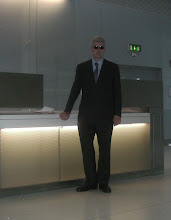A young engineer named Henri Coanda first tested a plane he had built powered by the worlds first jet engine of which he was the inventor. The engine was not a Turbo jet which was later invented by Frank Whittle and Von Ohain, but had a gasoline engine driven centrifugal compressor, a combustion chamber and nozzle. The sled picture below had no plates thus it's combustion chamber was omitted. It makes it safer, still reached speeds of one hundred miles per hour.
Coanda placed metal plates between the hot jet gases and the plywood fuselage. However instead of deflecting the jet away it deflected it onto the plates, ran along them and set his plane alight. Fascinated, he failed to notice he was approaching a wall at high speed until the last second, pulled back on the stick, became airborne enough to clear the wall, crashed and was thrown clear to watch his plane go up in flames. As flying was hazardous he built a sled without the combustion chamber. Now 107 years later, we can assume Henri was ignored. What this one invention could have given our planet. Coanda aircraft can be seen as a cleaner more fuel efficient way to travel. Small engine aircraft less toxic make take another thirteen years heck who's flaunting.New have rc designs that are different. As croanda jets are ejected from slots and then traverse a hard surface or wall. They are sometimes called a wall jet. This wall after the slot creates a non-symmetrical nozzle. The velocity of the jet immediately evacuates the molecules between it and the wall. This low pressure region cannot be relieved by ambient inflow as ambient air is on the other side of the jet and so the jet quickly deflects toward and runs tangent to the wall. The average pressure across a Coanda jet is lower than the average pressure across an unbounded round jet.
This means that the average velocity at any point in the Coanda jet is higher than in a conventional jet, at the same distance from the slot. It follows then that the pressure is lower at any comparable distance from the slot and the momentum and mass flow are higher at the same points. Todays technology these turbines could be electrical.





No comments:
Post a Comment